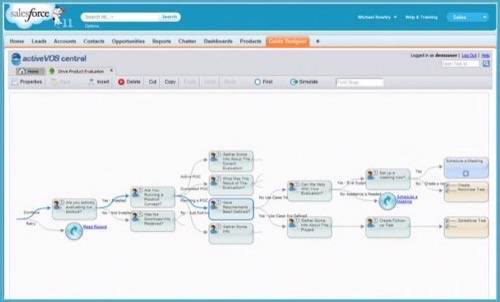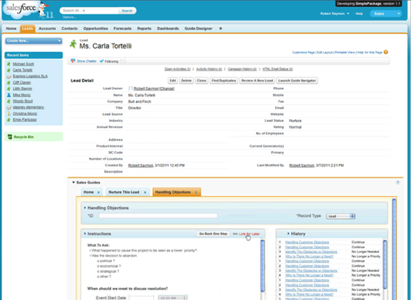A marketing manager helping me to un-mix my metaphors once explained to me that, in terms of software, a “tool” becomes an “environment” when it collects too many tools. Salesforce.com is an example of a product that has clearly metamorphosed into an “environment,” with this week’s Dreamforce ’11 conference in San Francisco devoting much of its space and time to tools that are integrating with Salesforce.

One prominent example is called Cloud Extend. Announced last April and officially launched this week by Active Endpoints, this tool endows Salesforce with workflow graphs called guidance trees, originally developed to assist in patient diagnosis, but with their sharp edges filed down to help agents maintain better customer relations.
“The reason we named it ‘Cloud Extend,” remarks Eric Egertson, Active Endpoints’ VP for Business Development, in anticipation of my obvious question, “is because we’re letting people add workflow and process automation to cloud applications. “Cloud Extend for Salesforce.com lets sales ops managers, marketing managers, sales managers – non-technical users, but subject matter experts – to add process automation to Salesforce.com.”
A stroll amongst the guidance trees
The typical SaaS application, Egertson argues, is fairly adequate at collecting, recording, and reporting data. The guidance tree metaphor lets a designer walk a sales rep through the typical steps for completing an everyday task or transaction. As he explains it, while his company was working with beta test partners, they pushed the company to move its workflow technology into Salesforce, away from this outside envelope. One such customer – consulting and training firm Bluewolf – came up with an example: a situation where it needs to schedule a meeting with multiple representatives of one of its clients, about an urgent business situation.

Another example guidance tree walks a sales rep through the Salesforce.com pipeline, asking for a self-evaluation for each one. “In our company, we create opportunities based on how far along we are in the sales cycle,” explains Egertson. “If we say it’s a committed deal… we should have an agreement on business terms, we should have the technical [plan] ready, so we walk the rep through those questions; and if they haven’t properly qualified that deal, it would change the status and write the data back to Salesforce.com.
“It puts the power of the decision of what to do next,” he tells RWW, “into the hands of the sales rep, who’s in the best position to know. But it reminds the sales reps to keep following, and to make suggestions about what to do.”
An Active Endpoints white paper explains the guidance tree principle:
Guidance trees are somewhat analogous to decision trees, but where decision trees are used to make a decision based on known data, guidance trees are for guiding a user through a set of questions, instructions and automated steps.
The problem being solved does not have to perfectly match to a tree. The guidance tree can also have leaves of the tree that are jump steps, which can go to any other step in the guidance tree, whether it is up the tree or down another branch. The jump step is labeled with the step it will jump to and the designer can click on the label to go there. This means that the designer is always seeing a tree, but the underlying model may actually be a graph. This works because the designer thinks of the main paths as the ones represented by the branches of the tree. The jump steps are needed, but it is not important that they be shown as lines on the canvas, as that would muddle up the main paths.
Working with a tree also makes it possible to reason about the problem as a tree. In a typical workflow or business process, there are only two levels at which it can be understood: the individual activity or the entire canvas. However, with a tree, every step in the tree can also serve as shorthand for all the steps that come after it in the tree. The design environment takes advantage of this. It is possible to cut, copy, paste and delete entire sub trees. Also, when one step specifies that a data field, such as a phone number, is required, then the system (and the designer) can treat it as a requirement that that phone number be present for all the steps that are down the tree from that step.
Getting trees in front of the right faces
According to data compiled by Active Endpoints and its partners, some 60% of leads never get more than one phone call, 80% never get more than two, 90% never more than three, 98% no more than four. Meanwhile, no-sales are typically registered on the first call. “The median number of calls it takes to make a sale is typically six.” Using that data, Cloud Extend and another partner, PSA Financial, coalesced to create what they call warmup plans – guidance trees that walk sales reps through the process of how to better optimize their phone time.
Salesforce may not be the only environment in which you’ll find Cloud Extend in the coming months. Active Endpoints CEO Mark Taber – a veteran of IBM’s Application Infrastructure Middleware group – tells RWW he has plans to integrate the product into cloud-based ERP platform NetSuite and human resource platforms Taleo and Success Factors.
“We want to enable anybody – a VP of sales, an operations person, an accounting manager, an HR manager – without any IT skills, with just ten minutes worth of training, to utilize these applications and get everyone else on board, and make sure their best practices are followed… When you’re looking at consultants, you no longer have to rely on the super-techie IT developers. Instead you’re working with business consultants who are focused on your industry and your type of company, who will share with you their guidance trees that would be applicable to you, so you can do the customization yourself. The consultants help you think through the process, rather than act as more IT staff.” says Taber.
In fact, integrating a tool into a software/service platform may be the only way to work that tool into the modern enterprise. It’s like programming a TV show, in a way – you have to know where your audience is. Right now, the audience is tuned to Salesforce; and not only are users investing their time but businesses their dollars, on a utility-driven scale. These platforms need to reap benefits by the month, not by the year or after four years’ time. If a company makes a visible investment in what we used to call a third-party application, that’s perceived as a bet against the platform in which the company is already vested – a kind of hedge.
This is especially interesting given Active Endpoints’ recent history. AE actually has a platform of its own, called ActiveVOS. It markets this as a business process management platform for IT, and its built-in screenflow development tool essentially is the guidance tree tool.
“You really don’t want to be building third-party type applications and new UI for these users,” explains Taber. “If you’re in sales, you buy Salesforce.com because you love its UI. Everybody has his anchor application that he wants to stay inside of. So this capability should be able to be seamlessly integrated, look like it’s a native application, and keep it inside the same UI.” Salesforce makes it easy for Active Endpoints and others to do these things, he went on, by providing SOAP Web service APIs for their developers.

At the Dreamforce conference this week, individuals who stop by the Cloud Extend booth (Moscone Center, booth #8), who provide their name, their company, and their picture, will find themselves populating the Salesforce database automatically via Cloud Extend, by way of LinkedIn. “We can poll social databases that are out there, and utilize that information as well as Salesforce Chatter,” says Taber. A Cloud Extend user can then use a guidance tree to trigger Salesforce Chatter messages on given conditions.
Like Salesforce, Cloud Extend uses a flat $50 per-user, per-month subscription, without complicated licensing. It’s available through AppExchange.com.










